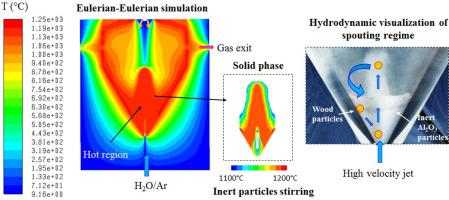当前位置:
X-MOL 学术
›
Chem. Eng. Sci.
›
论文详情
Our official English website, www.x-mol.net, welcomes your
feedback! (Note: you will need to create a separate account there.)
Experimental and CFD investigation of inert bed materials effects in a high-temperature conical cavity-type reactor for continuous solar-driven steam gasification of biomass
Chemical Engineering Science ( IF 4.1 ) Pub Date : 2020-12-01 , DOI: 10.1016/j.ces.2020.115970 Houssame Boujjat , Sylvain Rodat , Srirat Chuayboon , Stéphane Abanades
Chemical Engineering Science ( IF 4.1 ) Pub Date : 2020-12-01 , DOI: 10.1016/j.ces.2020.115970 Houssame Boujjat , Sylvain Rodat , Srirat Chuayboon , Stéphane Abanades

|
Solar biomass gasification was performed in a high-temperature conical bed reactor for thermochemical syngas production, which represents an efficient route to promote biomass valorization while storing intermittent solar energy into carbon–neutral solar fuels. The developed solar reactor is based on a conical cavity-type receiver enabling continuous biomass feedstock injection under real concentrated solar irradiation. In this study, the use of inert bed materials is considered to directly absorb a portion of the entering solar power and to transmit thermal energy to the gas and reactive particulate phase by radiation, convection and particle-to-particle interactions, with the aim of homogenizing the reactor temperature. A fluid dynamics study of the gas/particle flow was first performed to provide insights into the reactor hydrodynamics in the case of empty cavity and cavity containing inert particles in the forms of packed-bed and spouted-bed. The beneficial effect of the inert particles bed was emphasized. The spouted bed particles play a role in retaining the reacting biomass particles longer inside the reaction zone and promote phase mixing, as also confirmed by cold tests on a replicated transparent mockup cavity. Different inert particle bed materials were then considered and experimentally tested to unravel their impact on the biomass conversion, syngas composition and yield, and gasification performance in the solar-heated reactor operated at 1200 °C and 1300 °C.
中文翻译:

用于生物质连续太阳能蒸汽气化的高温锥形腔式反应器中惰性床材料效应的实验和 CFD 研究
太阳能生物质气化是在高温锥形床反应器中进行的,用于生产热化学合成气,这是一种有效的途径,可促进生物质的价值化,同时将间歇性太阳能储存为碳中性太阳能燃料。开发的太阳能反应器基于锥形腔式接收器,能够在真正集中的太阳辐射下连续注入生物质原料。在这项研究中,惰性床材料的使用被认为是直接吸收一部分进入的太阳能,并通过辐射、对流和颗粒间相互作用将热能传递到气体和反应颗粒相,目的是使反应器温度均匀。首先进行气体/颗粒流动的流体动力学研究,以了解在空腔和包含填充床和喷射床形式的惰性颗粒的腔的情况下的反应器流体动力学。强调了惰性颗粒床的有益效果。喷射床颗粒在将反应生物质颗粒保留在反应区内更长时间并促进相混合方面发挥作用,这也通过在复制的透明模型腔上进行的冷测试得到证实。然后考虑并通过实验测试不同的惰性颗粒床材料,以阐明它们对在 1200°C 和 1300°C 下运行的太阳能加热反应器中的生物质转化、合成气组成和产量以及气化性能的影响。
更新日期:2020-12-01
中文翻译:

用于生物质连续太阳能蒸汽气化的高温锥形腔式反应器中惰性床材料效应的实验和 CFD 研究
太阳能生物质气化是在高温锥形床反应器中进行的,用于生产热化学合成气,这是一种有效的途径,可促进生物质的价值化,同时将间歇性太阳能储存为碳中性太阳能燃料。开发的太阳能反应器基于锥形腔式接收器,能够在真正集中的太阳辐射下连续注入生物质原料。在这项研究中,惰性床材料的使用被认为是直接吸收一部分进入的太阳能,并通过辐射、对流和颗粒间相互作用将热能传递到气体和反应颗粒相,目的是使反应器温度均匀。首先进行气体/颗粒流动的流体动力学研究,以了解在空腔和包含填充床和喷射床形式的惰性颗粒的腔的情况下的反应器流体动力学。强调了惰性颗粒床的有益效果。喷射床颗粒在将反应生物质颗粒保留在反应区内更长时间并促进相混合方面发挥作用,这也通过在复制的透明模型腔上进行的冷测试得到证实。然后考虑并通过实验测试不同的惰性颗粒床材料,以阐明它们对在 1200°C 和 1300°C 下运行的太阳能加热反应器中的生物质转化、合成气组成和产量以及气化性能的影响。











































 京公网安备 11010802027423号
京公网安备 11010802027423号